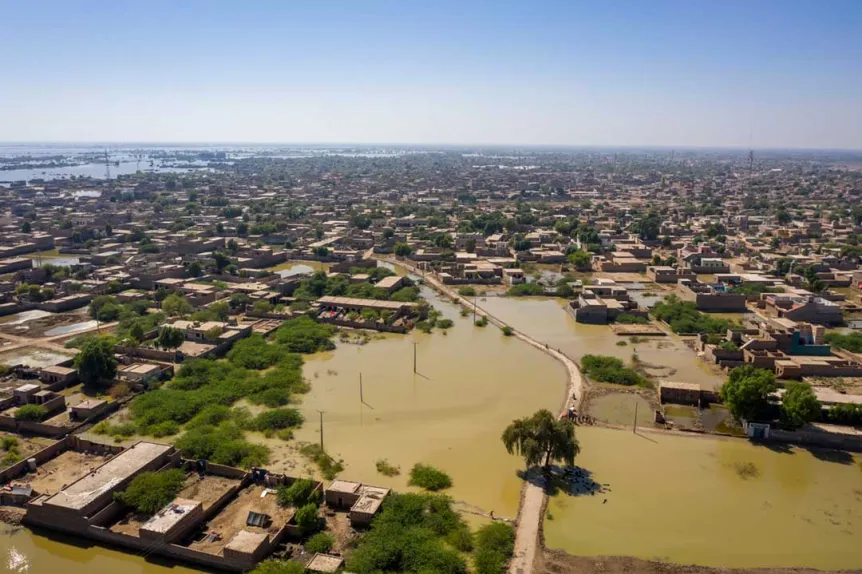One of the most significant issues facing South Asian nations, particularly Pakistan, is climate change. The ecosystem, infrastructure, and biodiversity of the nation are all impacted by the current climate change situation. Indeed, there is climate change. It is a growing issue globally, and its effects are particularly severe in Pakistan.
The situation is made worse by rapid industrialization, living in agricultural communities, utilizing plastic and fossil fuels, deforestation, and dirty cars. The main cause of global warming is also the emission of greenhouse gases (GHGs). Pakistan generates less than 1% of greenhouse gases, but its vulnerability to the consequences of global warming is greater.
Extreme monsoon rainfall and glacier melting are two aspects of the current weather patterns that led to catastrophic floods between July and September of 2022.
Pakistan is at the forefront of the global warming challenge. Climate injustice is glaringly obvious, as those who contribute little to climate change yet suffer disproportionately severe, frequently fatal, repercussions. Such a global climate emergency demands attention and action on a global scale.
Richer nations need to understand their critical role, said Dinushika Dissanayake, Deputy Regional Director for South Asia at Amnesty International. According to the Climate Rate Index, Pakistan is among the top 10 nations (CRI). Pakistan faces a significant threat from climate change as it is predominantly impacted by these activities, making it an international issue.
According to a study, if current trends in global warming continue, there will be increases in the average global temperature, sea level, and extreme weather events like storms, heat waves, cyclones, droughts, floods, etc. Pakistan has already experienced several devastating heatwaves, floods, and changes in rain patterns as a result of global warming.
Transportation, industrialization, and greenhouse gas emissions all contribute to global warming.
According to some recent research:
“Industries and transportation cause 80 % of global warming. The concentration of CO2 was about 280 per million (ppm) in the 18th century, but it is now more than 400 (ppm) in the atmosphere. Burning fossil fuels in industries and combustion in any other form are the main contributors to global warming.
The main contributor to climate change is an increased concentration of CO2, which is responsible for maintaining the greenhouse effect and global warming by around 11 %, escalating the earth’s normal temperature.”
The earth’s temperature rises in direct proportion to greenhouse gas emissions. The earth’s weather patterns are constantly shifting as a result of climate change and global warming. The average temperature of the earth has increased from 1.5 °C. The earth’s temperature will rise by 2 °C if the event persists, making life on the planet impossible. The cause of the severe rains, glacier melting, heat waves, droughts, increasing sea levels, etc. is now attributed to this change.
Every nation is concerned about global warming. The threat posed by climate change is real for the world. The global water system is impacted by climate change as well. Water shortages are now the world’s most important issue.
Heatwaves have a major impact on glaciers, and a recent study indicates that 68% of glaciers will disappear if global warming continues unchecked. Additionally, scientists expect that as greenhouse gas concentrations grow, temperatures will rise and people will be more susceptible to heat waves.
Due to their geographical locations and human activity, Pakistan and other South Asian nations are more susceptible to climate change than other nations. From east to north and south, Pakistan is encircled by three high-altitude mountain ranges, the majority of which are capped with ice caps and glaciers.
There are more than 7,000 glaciers in Pakistan. The anthropogenic actions of deforestation, unchecked rapid urbanization, and the lack of treatment of hazardous industrial effluents are altering global climate patterns and creating catastrophic droughts, floods, and increasing world temperature.
Pakistan has had over 150 instances of extreme weather since 2018. Approximately 14 major floods affected the nation during this time. Pakistan suffers losses in the form of livestock, infrastructure, and thousands of deaths as a result. Glacial Lake Outburst Floods (GLOF) are another risk that Pakistan faces as a result of the glaciers melting more quickly.
Since 2018, the melting of glaciers in Pakistan has resulted in the formation of around 3,000 glacier lakes. Flash floods are being brought on by climate change and glaciers melting in Pakistan’s Himalayan area. Pakistan in particular and other South Asian nations are severely affected by climate change, even though their share of greenhouse gas emissions is less than 1% of that of affluent nations.
“According to the European Commission’s report, China, the United States, India, the EU27, Russia, and Brazil were the six primary global emitters of (GHGs) in 2022.”
In addition to the consequences of climate change, heatwaves, floods, and wildfires are among the natural disasters that cause food insecurity. Twenty-one billion dollars’ worth of damage and almost 1,700 fatalities have resulted from the recent flooding in 2022. The primary source of Pakistan’s GDP (gross domestic product)—agriculture—was severely devastated by these floods.
The primary and most important pillar of Pakistan’s economy, the agriculture sector employs over 37.54% of the country’s labor force. Approximately 4 million crops were lost and 800,000 livestock perished during these floods. The output of agriculture decreased as a result.
This led to the displacement of 8 million people and the food and water insecurity of over 7 million people. There was also damage to around 34,204 schools, affecting 2.2 million children across flood-affected areas.
Pakistan has seen a significant increase in food insecurity as a result of climate change, and the disastrous flood and monsoon season of 2022 left approximately 5.7 million people without enough food. Pakistan is extremely susceptible to the effects of climate change, which hurt food and water availability as well as agricultural output.
Reduced agricultural productivity is a result of climate change, which also affects crop yields and seeds by altering rainfall patterns and causing erratic and unpredictable rainfall.
Due to standing water in flood-affected areas, the 2022 floods also brought diseases and infections, which resulted in a wave of death and devastation. Malaria infections soared fourfold or more in the country after the floods, from 400,000 in 2021 to nearly 1.6 million in 2022.
However, the events of 2022 were the worst in Pakistan’s 75-year history, and the flood was mostly caused by changes in precipitation patterns brought on by climate change, heavy rains, and glaciers melting quickly. During the August 2022 monsoon season, Pakistan got more than three times its typical amount of rainfall. For decades, the nation has also been plagued by catastrophic droughts, which are becoming longer and more frequent.
The repercussions of the rising global temperature are dire for Pakistan. With 250 million people living there, the nation experiences harsh weather variations and intense heat waves. Each year, the nation experiences intense heat waves that claim hundreds of lives.
Pakistan was identified as the epicenter of a global wave of dangers to climate health in 2023 by The Washington Post. Without any defenses or systems in place, severe and high heat waves frequently occur in Sindh, Punjab, and Baluchistan.
The country’s and the world’s rising temperatures are caused by both natural and human activity. The hottest temperature ever recorded in Jacobabad in 2021 was 51 °C in April. The lowlands and northern regions of the province of Khyber Pakhtunkhwa also saw a 2-degree Celsius rise in temperature.
Heat waves and rising temperatures also impact the production of crops since these factors weaken seeds, which leads produce to fade or growth more slowly. Increased temperatures also foster an environment conducive to the growth of pests, insects, and crop diseases.
The timing and intensity of insect and pest outbreaks are impacted by rising temperatures and shifting weather patterns, which cause damage to agriculture and increase the need for insecticides. In its assessment of global temperature, the IPCC predicted that by 2100, global temperatures might rise by 3 °C. Pakistan was ranked 140th out of 180 countries in terms of greenhouse gas emissions. Pakistan is the fifth most climate-vulnerable nation, according to GCRI rankings.
Pakistan’s springtime is also impacted by climate chang since the monsoon season has lasted longer than usual. Pakistan has had a brief spring season over time.
“Warmer conditions have started to affect Pakistan much earlier than usual,” stated Dr. Qamar-uz-Zaman Chaudhry, the former head of Pakistan’s Met Office and author of the country’s first climate strategy. The length of the spring season is decreasing. It is significantly affecting agriculture. Pakistan experiences a shorter spring season as a result of rising temperatures brought on by climate change, which affects agricultural output.
Pakistan is also experiencing a shortage of water as a result of population growth and environmental changes. The main supply of fresh water for drinking, daily usage, agriculture, and industry is groundwater. Pakistan is one of the most populous countries in South Asia, and it frequently experiences heat waves, droughts, floods, and other natural catastrophes.
The effects of climate change are also placing more strain on groundwater supplies. Pakistan is among the world’s most water-stressed nations, according to the World Bank. The need for groundwater is growing as the population grows.
With 250 million citizens, Pakistan rose to become the sixth most populous nation in the world. The primary causes of Pakistan’s water scarcity include the country’s fast population increase, inadequate water management, water pollution, and climate change, which results in more frequent heat waves, droughts, and floods.
The accelerated urbanization, industrialization, and population growth have led to excessive groundwater recharge and overpumping for daily needs. Food and water security have been negatively impacted by heat waves, droughts, floods, and unpredictable weather.
However, the issue is made worse by a lack of sensible management and policies, which lead to resource depletion, environmental degradation, and increased difficulties for ecosystems and society.
It illustrates the dire issue of water scarcity: The amount of water available per person in Pakistan has decreased recently, from 5,260 cubic meters in 1951 to 1000 cubic meters. The United Nations Development Programme (UNDP) projects that by 2025, Pakistan may experience a complete water shortage.
The Indus River, the nation’s main supply of water for residential consumption, industry, and agriculture, is especially vulnerable due to the country’s fast-changing climate and glacier melting. The rivers depend largely on the glaciers’ meltwater.
The glaciers in the Indus Basin have been melting at a rate of about 20 centimeters per year on average since the 1990s. The country’s river system receives less water as a result of this glacier mass loss, which also affects downstream water flow.
According to World Wildlife Fund (WWF) research, glacier retreat will cause the Indus River’s flow to drop by up to 40% over the next few decades. The irrigation system and the amount of water available for residential and commercial use are also impacted by this drop in water flow.
Water shortage affects not just the environment but also society and the economy because it has a direct effect on people’s capacity to make ends meet and maintain their level of living.
Pakistan is severely affected by global warming and climate change. Frequent and intense rains, natural disasters including floods and droughts, changes in weather and agricultural patterns, and food and water scarcity are some of the major issues facing the country.
To lessen the impact and repercussions of climate change on the nation, immediate action is needed. This action includes developing infrastructure, raising public awareness of climate change, and implementing sustainable management and regulations. Pakistan may lower its risk of climate change and build a more resilient and sustainable future by implementing sustainable measures.
Climate change and global warming pose a worldwide threat rather than a domestic one. Rising temperatures are a result of industrialization, deforestation, and greenhouse gas emissions. Every nation ought to take action to aid in lowering the temperature.
To reduce pollution, everyone should participate—not just the government. Planting more trees would be a better way to reduce the temperature because they absorb carbon dioxide and other greenhouse gases and create a pleasant atmosphere. To prevent a climatic disaster, smart transport systems and switching from fossil fuels to renewable energy sources can solve this threat.

Table of Contents
ToggleHadia Safeer Choudhry
Hadia Safeer Choudhry is anInternational Relations student with a solid academic basis in Diplomatic Relations, International Law, and Intercultural Communication. Her writings focus on international relations, feminism, and current trends.
- Hadia Safeer Choudhry
- Hadia Safeer Choudhry













